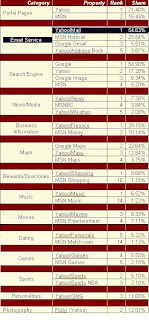According to Tancer (2008, p 1), the market share for Internet visits are:

Tancer goes on to breakdown the total visits into the Experian Web site segments as follows.
Click image to expand.

Market Segments and MSN Points of Parity
Chickowski (2008, p 2) notes that Yahoo, Google and MSN all offer similar services, although Google has been far more effective in establishing points of difference in services that attract high page hits. A chart of favorable brand salience with each group is based on the studies of Rosoff (2006), Tancer (2006), and Chickakowski (2008).
Microsoft can use this chart to map its competitive brand strategy for MSN/LIVE. As we will see in the next section, MSN has strong presence in the Editor Collated Content arena. I propose this area can be exploited to establish rich communications with strategic buyers by placing noteworthy Editor’s in a Corporate Governance line extension of MSN/LIVE. In addition, MSN has a valid point of presence in each category.
Like Yahoo, MSN has the same set of tools and applications as those provided by Google, according to Chickakowski (2008, p 2). Keller (p 110) notes that MSN’s service is not required to be equal to Google to establish a point of parity but rather just “good enough.” Finally, the Tancer (2006, p 1) study found that while Yahoo was considered as a destination site and Google as a search site, MSN/LIVE was both.
Click image to expand.

MSN Points of Difference
According to Rosoff (2006, p 2), MSN makes content available that is collated by editors who work for either MSN or an MSN content partner. As noted in sections one and four, my proposal is to create customized and searchable corporate governance collections for customers who are strategic buyers. They will be attracted to Editor Collated Content that has been customized for them and that regards corporate governance. This will not only create a rich communication with these wealthy buyers on MSN/LIVE and thereby enhance the MSN operations, but will also enhance the communications between Microsoft and these corporate clients, which are increasingly lured by Open Source and “Software as a Service” alternatives to Windows.
Another point of difference would be that Microsoft has major resources world-wide that it can utilize to provide customer assistance to strategic buyers. It has a skillful sales force that is accustomed to fulfilling demanding assignments. It has a well-organized support structure to disseminate information and software updates as well as a competent consulting arm (MCS) with a field-tested project methodology that has a proven record of success. Finally, Microsoft has stable relations with the corporate world, which makes negotiating and executing contracts straightforward. This is known as social capital.
References
Chickowski, Erica (02/08/2008). Brand Identities After a Microsoft and Yahoo Deal. Baseline. Retrieved on November 22, 2008 from http://www.baselinemag.com/c/a/Messaging-and-Collaboration/Brand-Identities-After-a-Microsoft-Yahoo-Deal/1/
Keller, K (2008). Strategic Brand Management. Pearson/Prentice-Hall.
Rosoff, M (October 23, 2006). The Future of MSN. Directions on Microsoft. Retrieved on November 22, 2008 from http://www.directionsonmicrosoft.com/sample/DOMIS/update/2006/11nov/1106tfom.htm#top
Tancer, Bill (August 3, 2006). Google, Yahoo! and MSN: Brand Association. Hitwise Intelligence. Retrieved on November 22, 2008 from http://weblogs.hitwise.com/bill-tancer/2006/08/google_yahoo_and_msn_brand_ass.html


No comments:
Post a Comment